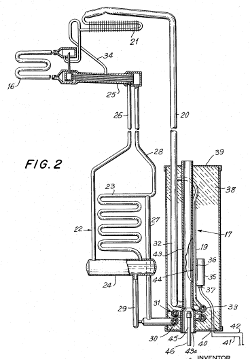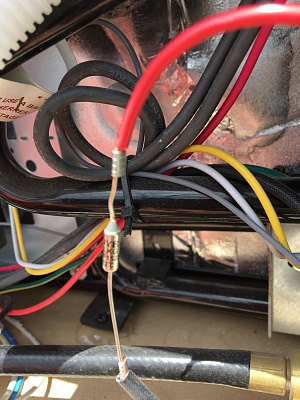This page shows 3 patents filed between 1965 & 2007 that demonstrate the fact that boiler overheating results in RV fridge damage.
The brown font on this page is text quoted from the following patents and recall publications.
FYI: Dometic is Electrolux USA division.
Instructions: Subjects are listed on left. Click the link to the right to go directly to the subject matter on this page.

"During normal operation different parts of the unit are heated to elevated temperatures which are within a safe operating range which does not impair the life of the refrigeration apparatus."
Click here to go directly to Electrolux Patent.Why else would it state in the patent "abnormally high elevated temperatures tend to shorten the life of the refrigeration apparatus"?

"Such abnormally high boiler temperatures involve the risk that corrosion-protecting components, such as a type of chromates, added to the solution are consumed in a shorter period of time than what is considered to be normal."
OK, so the Fridge Defend by ARP limits "abnormally high boiler temperatures" which in turn protects "corrosion-protecting components" from consumption resulting in a safer and longer lasting RV fridge.
How can one that patents a new boiler assembly, say in their patent specification that an advantage to the design is to "prevent creation of undesirable excess temperature in the boiler" when the "temperature will rise to an unacceptable extent", then turn around and say that the Fridge Defender by ARP is not a necessity?

We will explore the "containment system" patent and then finally move to a Dometic press release. Please note that the solution to, what is described above as a condition that leads to overheating of the cooling unit boiler "includes a thermofuse 230 (or thermal fuse)". It is clearly stated that the motivation for the thermal fuse is to detect "an abnormal rise in temperature near the boiler ", not at the boiler.
Kind of funny, this method of dealing with a boiler overheat situation is to measure outside the boiler housing ("near"), which is outside the insulated boiler. This method clearly does not prevent problems. On the other hand, the Fridge Defender detects boiler overheat before it can do damage thereby reducing the need for a "containment system" and making your fridge safer and more reliable.

The 2nd photo shows a burned recall. The recall can be called many things, a thermofuse, a thermal fuse, or a thermal switch. This fridge had a minor fire that burned the wires off of the recall, obviously being "near" the refrigeration boiler did not prevent a fire.
Click here to see video and see if this recall will prevent a fire or protect your fridge.
This photo show the thermal fuse that is behind the burner assembly. Click here to download datasheet for this part.
Dometic's published solution for, stated as " total number of units recalled – 926,000 – is considerable by most standards " and goes on to say "clearly, this is a safety issue ... that the development of this kit is one of the good things that came from our current situation." because " thousands of man-hours have gone into its [recall] development and testing. "
Let's explore what is described as a " double redundancy set of fuses ... our number one priority is keeping our customer and the vehicle from harm. " In addition to the " containment system " and " thermofuse 230 (or thermal fuse) " the thermal part of the recall and subsequent solution is a CANTHERM Thermal Cut-Off Part Number DF152S. This switch is mounted in the refrigeration compartment so it measures the air temperature. We first want you to understand that if the air temperature in the cooling unit compartment gets over ~130°F, the cooling process stops and damage that leads to " event of a fire " can occur.
So what does the recall part DF152S do? If the air in the compartment gets to 262°F, the recall will not trip. That is, this thermal fuse can be operated at temperatures up to 262°F without the recall having any safety response. This is 2 times the temperature of ~130°F where damage starts to occur! In the " event of a fire " the air temperature in the cooling unit compartment has to reach 306°F according to the manufacture specification before the fuse will turn off the power to the fridge. Restated, the air in the compartment has to get to 306°F according to the manufacture specification, this is 2.3 times higher than what would be considered a safe temperature at which to turn off the refrigerator because the cooling system is experiencing problems that lead to failure.
Why not take a proactive approach like the Fridge Defend does, the Fridge Defend monitors the heart of the cooling unit, the boiler. After all, it is the boiler overheating that leads to the damage that results in most RV fridge failures!